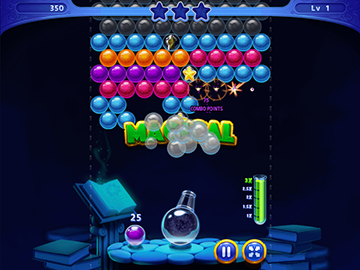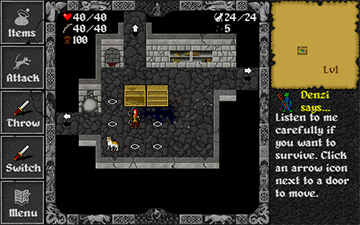Phaser is a fast, free, and fun open source HTML5 game framework. It uses a custom build of Pixi.js for WebGL and Canvas rendering, and supports desktop and mobile web browsers. Games can be compiled to iOS, Android and native desktop apps via 3rd party tools. You can use JavaScript or TypeScript for development. Years after release, Phaser is still one of the most starred game frameworks on GitHub.
Thousands of developers worldwide use Phaser. From indies and multi-national digital agencies, to schools and Universities. Each creating their own incredible games.
Phaser v2 was originally built and maintained by the company Photon Storm, but was turned over to the community in November 2016.
Visit: The Phaser website and follow on Twitter (#phaserjs)
Learn: API Docs, Support Forum and StackOverflow
Code: 700+ Examples (source available in this repo)
Read: Weekly Phaser World Newsletter
Chat: Slack and Discord
Extend: With Phaser Plugins
Be awesome: Support the future of Phaser
Grab the source and join in the fun!
- What's New?
- Support Phaser
- Phaser World Newsletter
- Download Phaser
- Getting Started
- Building Phaser
- Games made with Phaser
- Requirements
- Change Log
- Contributing
23rd March 2017
Phaser CE is the Community Edition of Phaser. In short, it's a version of Phaser that you, the community, have direct control over.
It was started with the 2.7.0 release and since then the community has worked to continue updating it, fixing bugs and adding new features.
Phaser 2 was a massive milestone for us, and we're still constantly amazed at all the cool things you created, and continue to create with it. Thank you to everyone who has submitted an issue or pull request over the years, or helped the framework grow in any shape or capacity.
As of today all of our in-house resources are spent on building Phaser 3 and beyond. However we fully recognize that lots of you still use Phaser 2, and have a lot to contribute to its future. So this is what we've done:
- Phaser 2.6.2 is the last 'official' release, published on npm as
phaser - Phaser 2.7.0 and all future versions have been given to the community to maintain, published on npm as
phaser-ce
All Pull Requests made against this repo will be unconditionally approved.
We'll give GitHub permissions to a select few individuals to help with this process if they request them. And when you, the community, request it, we will publish new versions to npm.
We believe this set-up will give us the best of both worlds. It will allow us to continue focusing our efforts on Phaser 3. And it will allow the community to enhance Phaser 2 for as long as they wish.
As always, check the Change Log to see what was added recently.
Keep your eyes on the web site, and subscribe to the weekly Phaser World newsletter. You can also follow on Twitter, or chat in the Phaser Slack and Discord channels.
There are also now more ways than before to help support the development of Phaser. The uptake so far has been fantastic, but this is an on-going mission. Thank you to everyone who supports our development. Who shares our belief in the future of HTML5 gaming, and Phasers role in that.
Happy coding everyone!
Cheers,
Rich - @photonstorm
Developing Phaser takes a lot of time, effort, and money. There are monthly running costs; such as the forum and site, which we maintain 100% ad-free. As well as countless hours of development time, community support, and assistance resolving issues. We do this out of our love for Phaser of course, but at the end of the day there are real tangible costs involved.
If you have found Phaser useful in your development life. Or have made income as a result of using it, and are in a position to support us financially, without causing any detriment to yourself, then please do. There are a number of ways:
- A monthly contribution via Patreon.
- A one-off donation via PayPal.
- Purchase any of our plugins or books.
- Companies can sponsor a release of Phaser, or an issue of our newsletter.
It all helps cover our running costs, and genuinely contributes towards future development.
If you would like to sponsor Phaser then please get in touch. We have sponsorship options available on our GitHub repo, web site, and newsletter. All of which receive tens of thousands of eyeballs per day.
Every Friday we publish the Phaser World newsletter. It's packed full of the latest Phaser games, tutorials, videos, meet-ups, talks, and more. It also contains our weekly Development Progress updates. If you want to know what we're working on, this is the newsletter to read!
Previous editions can found on our Back Issues page.
Phaser is hosted on Github. There are a number of ways to download it:
- Clone the git repository via https, ssh or with the Github Windows or Mac clients.
- Download as zip or tar.gz
- Download just the build files: phaser.js and phaser.min.js
- Checkout with svn
Install via bower
bower install phaser
Install via npm
npm install phaser-ce
Using Browserify? Please read this.
jsDelivr is a "super-fast CDN for developers". Include the following in your html:
<script src="//cdn.jsdelivr.net/phaser-ce/2.7.5/phaser.js"></script>
or the minified version:
<script src="//cdn.jsdelivr.net/phaser-ce/2.7.5/phaser.min.js"></script>
If you'd like to try coding in Phaser right now, with nothing more than your web browser, then head over to the Phaser Sandbox. You'll find Quick Start templates, and a user-friendly editor filled with handy code-completion features.
Phaser is released under the MIT License.
Our Getting Started Guide will get you up to speed quickly. From setting up a web server, to picking an IDE. After which read our Making your first Game tutorial. Please work through this, no matter what your development experience, to learn how Phaser approaches things.
The single biggest Phaser resource is the Phaser web site. You'll find hundreds of tutorials, with new ones added every week. Subscribe to the Phaser World newsletter for a weekly links round-up.
Using TypeScript? Game From Scratch has a great series of tutorials covering that.
Prefer videos? Zenva have an excellent Phaser video course, with hours of great material.
Ever since we started Phaser we've been growing and expanding our extensive set of examples. Currently there are over 700 of them, with the full source code and assets available.
Browse the Phaser Examples, or clone the examples repo, and eat your heart out!
Interphase is a programming book for Phaser developers of all skill levels.
With 400 pages of content you'll find detailed articles, game development "Making Of" guides and tutorials. All were written using the latest version of Phaser, so you won't be learning any out-dated tricks.
As well as the book you get all the source code, graphics and assets to go with it, and lots of extras too.
Phaser Editor is a brand new Eclipse based editor that offers lots of built-in tools specifically for Phaser developers. Handy features include Smart code auto-completion, built-in web server, documentation search, asset management, texture atlas creator, audio sprite creator, asset previews and lots more.
The Game Mechanic Explorer is a great interactive way to learn how to develop specific game mechanics in Phaser. Well worth exploring once you've got your dev environment set-up.
MightyEditor is a browser-based visual Phaser game editor. Create your maps with ease, position objects and share them in seconds. It also exports to native Phaser code. Excellent for quickly setting-up levels and scenes.
Phaser is provided ready compiled in the build folder of the repository. There are both plain and minified versions. The plain version is for use during development, and the minified version for production. You can also create your own builds.
Phaser includes a grunt based build system, which allows you to strip out features you may not require, saving hundreds of KB in the process. Don't use any Sound in your game? Then exclude the entire sound system. Don't need Keyboard support? That can be excluded too.
As a result of this work the minimum build size of Phaser is now just 80KB minified and gzipped.
See the Creating a Custom Phaser Build tutorial for details.
Phaser was never written to be modular. Everything exists under one single global namespace, and you cannot require selected parts of it into your builds. It expects 3 global vars to exist in order to work properly: Phaser, PIXI and p2. The following is one way of doing this:
window.PIXI = require('phaser/build/custom/pixi')
window.p2 = require('phaser/build/custom/p2')
window.Phaser = require('phaser/build/custom/phaser-split')
If you build a custom version of Phaser it will split the 3 core libs out into their own files, allowing you to require them as above.
We appreciate this is just a band-aid, and not a proper use of modules, but please understand it was never built to be used this way. You're trying to fit a square peg in a round browserify-shaped hole, so compromises have to be made. Please don't open GitHub issues about it as we've no intention of changing Phaser at this stage of its life. Full module based development is available in Phaser v3.
Starting from Phaser 2.4.5 we now include a custom build for Webpack.
You need to add p2 as a dependency.
var path = require('path');
var webpack = require('webpack');
var phaserModule = path.join(__dirname, '/node_modules/phaser/');
var phaser = path.join(phaserModule, 'build/custom/phaser-split.js'),
pixi = path.join(phaserModule, 'build/custom/pixi.js'),
p2 = path.join(phaserModule, 'build/custom/p2.js');
module.exports = {
...
module: {
loaders: [
{ test: /pixi.js/, loader: "script" },
]
},
resolve: {
alias: {
'phaser': phaser,
'pixi.js': pixi,
'p2': p2,
}
}
...
}
require('pixi.js');
require('p2');
require('phaser');
Should you wish to build Phaser from source you can take advantage of the provided Grunt scripts. Ensure you have the required packages by running npm install first.
Run grunt to perform a default build to the dist folder.
Releases of new versions of Phaser CE are under the communities control. If you feel there are sufficient fixes, or important ones that warrant a new version release, then please do the following:
-
Make sure the version number is increased, in line with semver policies, in the following files:
package.jsonandsrc/Phaser.js -
Make sure that you have added details of the new version to the
README.mdandCHANGELOG.md. This should include a summary of changes made in the version. You can usually obtain this from the commit / PR history. It's nice to credit who made the changes by linking to their GitHub user ID, but isn't a requirement. -
From the root repo folder, run
grunt jshintand make sure there are no jshint errors. If there are, please fix them, or request that the original author of the code does so. -
Once jshint passes run
grunt release, sit back, and wait. It will build all of the versions of Phaser required, update the doc files, TypeScript defs and lots more. When finished, commit all of the new files and make sure to include a clear message in your commit saying you want this release pushed to npm. Be sure to tag me when doing this, i.e. 'Phaser CE Version 2.X.X. Please publish to npm @photonstorm' - I'll see it, and then publish as soon as I can (often the same day).
Thousands of games have been made in Phaser. From game jam entries, to titles by some of the largest entertainment brands in the world. Here is a tiny sample. You can find hundreds more on our web site.
Artwork copyright their respective owners.
We add new games to the Phaser site weekly, so be sure to send us yours when it's finished!
Phaser requires a web browser that supports the canvas tag. This includes Internet Explorer 9+, Firefox, Chrome, Safari and Opera on desktop. iOS Safari, Android Browser and Chrome for Android are supported on mobile.
While Phaser does its best to ensure a consistent cross-platform experience, always be aware of browser and device limitations. This is especially important with memory and GPU limitations on mobile, and legacy browser HTML5 compatibility.
If you need to support IE9 / Android 2.x and use P2 physics, then you must use the polyfill in the resources/IE9 Polyfill folder. If you don't use P2 (or don't care about IE9!) you can skip this.
Phaser is developed in ES5 JavaScript. We've made no assumptions about how you like to code, and were careful not to impose a strict structure upon you. You won't find Phaser split into modules, requiring a build step, or making you use a class / inheritance OOP approach. That doesn't mean you can't do so, it just means we don't force you to. It's your choice.
If you code with TypeScript there are comprehensive definition files in the typescript folder. They are for TypeScript 1.4+.
- TypeScript definitions fixes and updates (#75, #101)
- Docs typo fixes (#101)
- Phaser now destroys BitmapData and RenderTexture objects when clearing the cache (#68). This should reduce memory use.
game.add.weaponnow has abulletClassargument. Without this it was difficult to setbulletClassbefore creating the bullet pool.
- Fixed an issue when dragging a sprite whose parent is scaled or rotated (#108). Now the sprite follows the cursor correctly.
- Fixed audio skipping when restarting playback (#78)
- Fixed bad rendering of multiple tinted BitmapText objects (#58)
- Fixed Object.assign not existing on older devices (#81)
- Previously, passing
renderer: Phaser.HEADLESSto a new Game would setgame.renderTypetoPhaser.CANVASand set up the Canvas renderer, which was incorrect (#74).Phaser.HEADLESSnow sets up a PIXI.CanvasRenderer and<canvas>(like before) but doesn't add the canvas to the document. It skipsrenderhooks but not thepreRenderandpostRenderhooks (strange).
- A hotfix to patch the error
this.preUpdateLifeSpan is not a functionin 2.7.4 (#72)
- New method Phaser.Math.hypot() calculates the length of the hypotenuse spanning two given lengths
- Added copyBitmapData function to Phaser.Bitmap
- Added noPause logic to src/input/Pointer.js
- Added timeStep parameter pass to state.pauseUpdate call at src/core/Game.js
- Added
tileOffset(Phaser.Point) property toPhaser.TilemapLayer. This allows offsetting layer positions in a way that plays well with the camera and Arcade physics. Also, theoffsetxandoffsetyproperties are now read from the layer properties of Tiled maps.
- Changed Loader.loadImageTag behavior to exclude firefox from loading cached images (#2534)
- Added yarn lock file
- Added travis-ci build script
- Fixed Phaser.Plugin.AStar Typescript definitions and phaser-ce module name to get
grunt tsdocsto work again (#33) - Fixed Phaser.Plugin.AStar.DISTANCE_MANHATTAN according to documentation
- Changed bower package name to
phaser-ce - Emitter.explode() now launches all particles if the
quantityargument is omitted (#7). You should pass quantity0if you want to launch no particles. overlapR,overlapX, andoverlapYare now reset to 0 when an Arcade Physics Body isn't colliding (#23)- Extened Phaser.Physics.P2.Body.loadPolygon() method by scale parameter, that allows the loaded polygon to have a different scale
- Fixed documentation of Phaser.Video#createVideoFromBlob
- Clarify documentation of Phaser.AnimationManager#updateIfVisible
- Update Phaser.Text#setStyle to not mutate the passed style
- Extended Phaser.Particles.Arcade.Emitter#makeParticles by parameter to pass custom parameters to particle class
- Fixed jshint issues (#46)
- Added call of preUpdateLifeSpan for Phaser.Image#preUpdate (#46)
- Added missing parameter particleArguments at typescript definition file (#46)
- Updated changes at readme and changelog markdown (#69)
- Fixed Arcade.Body.reset() so it resizes the body if the sprite scale has changed (#10).
- Fixed Phaser.Camera.checkBounds() so it doesn't flicker when its view is bigger than its bounds.
- Fixed Phaser.Math#between and Phaser.Math#random to work again
- Reset loader state at Phaser.Loader before complete callbacks (#53)
- Fixed rendering on devices that use older versions of javascript
- Fixed crashes on very old devices
- Phaser.Group#update Fixed group updating if a sprite has been destroyed
- Phaser.Weapon#fire Fix local rotation tracking (#66)
- Fixed memory leak on webaudio at Phaser.Sound
- Fix wrong parameter by calling Phaser.RenderTexture in pixi _generateCachedSprite at DisplayObject
- Fixed jshint issues
- Added preUpdateLifeSpan for Image
- Added missing parameter particleArguments at typescript definition file
- Fixed duplicate touch events in Android Chrome >= 55 due to introduction of PointerEvents.
For changes in previous releases please see the extensive Version History.
The Contributors Guide contains full details on how to help with Phaser development. The main points are:
-
Found a bug? Report it on GitHub Issues and include a code sample.
-
Before submitting a Pull Request run your code through JSHint using our config.
-
Before contributing read the code of conduct.
Written something cool in Phaser? Please tell us about it in the forum, or email support@phaser.io
Phaser is a Photon Storm production.
Created by Richard Davey. Powered by coffee, anime, pixels and love.
The Phaser logo and characters are © 2017 Photon Storm Limited.
All rights reserved.
"Above all, video games are meant to be just one thing: fun. Fun for everyone." - Satoru Iwata



































